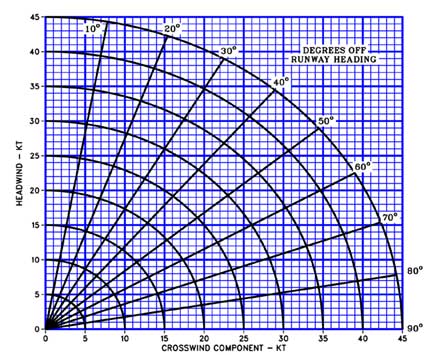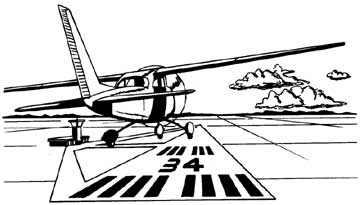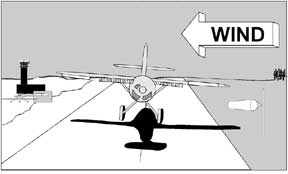Crosswind Landings
A Different Perspective
While the number of general aviation accidents have been decreasing for the last five years, the latest statistics (FAA database, AOPA Air Safety Foundation, and the Nall Report) show that most general aviation aircraft accidents occur during the landing phase of flight due to a lack of piloting skills or the exercise of poor judgment.
If you check any particular year’s accident statistics, it won’t matter what year you choose, you will find the same things are causing the same accidents year after year.
Crosswind landings and the loss of directional control on the ground because of the improper use of the controls are the leading problem areas.
 Pilots
who attend safety meetings rank low in the accident statistics. I
have invited several pilots with questionable proficiency to these
meetings, but they always have some excuse. It is the pilots who do
not attend these meetings who are contributing the greatest to the
general aviation accident rate. The saying, "The proficient pilot
drinks at the fountain of knowledge; the accident pilot just
gargles," seems to sum it up.
Pilots
who attend safety meetings rank low in the accident statistics. I
have invited several pilots with questionable proficiency to these
meetings, but they always have some excuse. It is the pilots who do
not attend these meetings who are contributing the greatest to the
general aviation accident rate. The saying, "The proficient pilot
drinks at the fountain of knowledge; the accident pilot just
gargles," seems to sum it up.
Crosswind operations are the single weather phenomena that is contributing to landing accidents. During the year 2000, only 10 of the 465 accidents attributed to crosswind landing accidents occurred during crosswinds of greater than 15 knots. That means 455 accidents occurred with crosswinds of 15 knots or less. That seems improbable, but it’s true.
 Determine
degrees off runway heading (wind angle
Determine
degrees off runway heading (wind angle
between runway and wind direction). Move along
this line to the wind velocity. Move vertically
downward for the crosswind component.
So why is there a problem? The FAA thinks it is due to the increased workload during the landing phase of flight. This may be true to a certain degree, but I think some pilots have learned to perform crosswind operations by rote, the lowest level of learning. They have been taught that with a wind from the left, the left wing is lowered an amount that will stop the sideward drift and they use opposite rudder (left aileron control and right rudder) to maintain directional alignment with the runway.
Actually this side slip is the preferred method of executing the crosswind landing. The aileron is used first and before the nose yaws, the rudder is used. If the wind quits, relax both controls at the same time and the airplane will maintain its longitudinal alignment.
 Some
pilots like to crab the airplane into the wind and fly the crab to
the runway. During the flare, just before touchdown, the rudder is
"kicked" (pushed sufficiently to align the longitudinal axis with
the centerline of the runway). When the rudder is depressed, a
corresponding amount of opposite aileron is required to maintain the
wings level. The timing has to be perfect to prevent side loads on
the landing gear. I don’t prefer this method; although when flying
the Citation X with its swept wings, this was the only method that
would prevent me from striking a wing tip.
Some
pilots like to crab the airplane into the wind and fly the crab to
the runway. During the flare, just before touchdown, the rudder is
"kicked" (pushed sufficiently to align the longitudinal axis with
the centerline of the runway). When the rudder is depressed, a
corresponding amount of opposite aileron is required to maintain the
wings level. The timing has to be perfect to prevent side loads on
the landing gear. I don’t prefer this method; although when flying
the Citation X with its swept wings, this was the only method that
would prevent me from striking a wing tip.
The wing down or side slip procedure is considered the best method for landing a light single-engine aircraft in crosswind conditions. Rather than start the slip after turning base to final, fly the crab until you get close to the runway. As a general rule, the wind shifts counterclockwise and/or decreases in velocity when descending. If you try the slip after turning final, you might run out of rudder control to maintain alignment and think the crosswind is too strong for landing. Waiting until about 30-50 feet above the runway to transition to the slip helps in this regard.
Pilots, in order to receive a pilot certificate, have to learn to perform this side slip, so the problem seems to be that the wind rarely maintains a constant velocity and constant direction during the approach to land.
Back in the late 60’s, I taught the side slip to students for getting down during crosswind landings. One day while monitoring the progress of a student, we were performing crosswind landings with the wind from the left. The student set up the proper slip and was maintaining alignment with the extended centerline of the runway when the wind shifted to the right of the nose. The student flew back to the runway centerline and set up the side slip to the left again although the wind was now from the right. Progressing from "rote," the student graduated to "understanding" and realized the wind had shifted and switched to a side slip to the right. The student was gaining on crosswind operations, but lacked the "application" and "correlation" phases of learning. Again the wind shifted and the student was flying back to the centerline, then resuming the right side slip. It just didn’t work out too good.
As a result of this lack of "application" learning, I decided to change the way I taught crosswind landings. Rather than teach the side slip, I thought I could teach the student to maintain runway centerline alignment with the ailerons, moving left and right as required to stay over the centerline. A change in aileron deflection causes a yaw of the nose (adverse aileron drag). So now, combined with maintaining alignment with the ailerons, the student also had to maintain longitudinal alignment with the rudders.
 My
"guinea pig" student and I went out on one particularly gusty day to
put the new method to test. The student seemed overly anxious and I
casually mentioned, "Looks like you’ve got butterflies in your
stomach." He said, "Butterflies, hell, those are bats."
My
"guinea pig" student and I went out on one particularly gusty day to
put the new method to test. The student seemed overly anxious and I
casually mentioned, "Looks like you’ve got butterflies in your
stomach." He said, "Butterflies, hell, those are bats."
This student, experiencing gusty wind conditions and changes in wind direction, was able to maintain lateral and longitudinal alignment without thinking of the side slip. Obviously he performed the side slip, but thought about it in different terms ... ailerons for lateral alignment, rudders for longitudinal alignment. Let me warn you, at times it requires rapid and aggressive movement of the ailerons and rudder to maintain runway alignment.
What about flaps? You can prove that airplanes have more "air control" with the application of flaps. If you go out and establish a 30-degree bank, you can "lock" the controls and apply flaps. The airplane will roll into a steeper bank. This proves that a certain amount of aileron deflection causes a greater bank when used in conjunction with flaps, so the ailerons are more effective.
This increased aileron effectiveness seems to indicate the need for using flaps to have sufficient aileron control in gusty winds, but the airplane will run out of rudder control before it runs out of aileron control.
I admit that flaps give more "air control," but it is also true that the airplane has less "ground control" with the flaps extended, especially taildraggers. This is because the flaps direct airflow away from the elevator and rudder making the plane more susceptible to weathercocking.
Usually if the wind is more than 10-15 knots direct crosswind, to have more ground control, limit the flaps to half. More than 15 knots, consider only 25 percent flaps at the most, or land with the flaps retracted.
Crosswind Procedure:
-
Turn onto final approach and establish a crab to maintain the extended runway centerline alignment.
-
Transition to a slip at about 30- to 50-feet AGL.
-
Aggressively maintain lateral alignment with the ailerons and longitudinal alignment with the rudder.
-
Flare to a "level flight" attitude at about 5- to 10-feet AGL. Maintain this attitude until the airplane begins to sink while keeping lateral and longitudinal alignment.
-
Touchdown on the upwind wheel and maintain ailerons into the wind.
-
If flaps are used, retract them (not the gear) once on the ground. This is contrary to FAA advice that states you shouldn't touch anything until you are clear of the runway. Consider doing it anyway to get more weight on the wheels for better directional control.
-
If the approach or landing is not working out, perform a go-around maneuver.
Wishing you blue skies, tail winds and safe flying!
|
|
|

